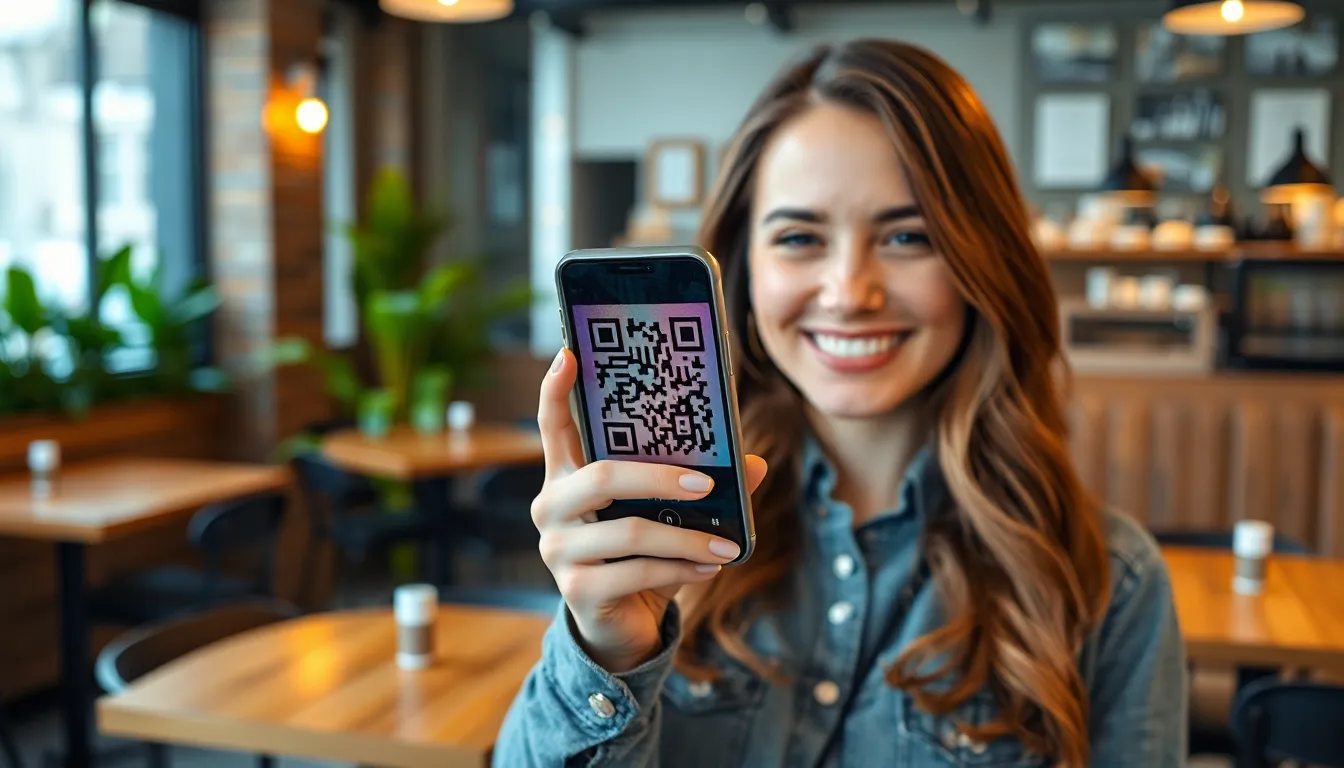In a world where everyone’s glued to their smartphones, QR codes have become the cool kids on the block. They’re like magic portals that take people straight to your website, social media, or any link you want. Imagine turning a simple flyer or business card into a digital treasure map—now that’s some wizardry worth exploring!
Table of Contents
ToggleUnderstanding QR Codes
QR codes, or Quick Response codes, serve as a bridge between the physical and digital worlds. These two-dimensional barcodes encode information, allowing smartphones to scan and instantly access linked content. Users benefit from this instant access by simply pointing their device’s camera at the code.
Different forms of data can be embedded within QR codes. Links to websites, social media profiles, and videos typically reside within these codes, making them versatile tools for various applications. Data is stored by arranging black squares in a square grid against a white background, leading to quick recognition and action.
Privacy considerations exist while using QR codes. Users should remain cautious about scanning unknown codes, especially those that lead to unverified links. Malicious QR codes could redirect users to fraudulent websites or compromise personal information.
Businesses have increasingly adopted QR codes in marketing strategies. With 83% of consumers indicating familiarity with QR codes, their effectiveness for promoting products and engaging customers has risen sharply. Customers encounter these codes on advertisements, restaurant menus, and event tickets, creating efficient pathways to accessible information.
Creating a QR code involves simple steps. Online QR code generators provide user-friendly interfaces to generate codes for URLs, text, emails, and more. Users only need to input their desired link, choose a pattern or color, and download the generated code for use.
Adopting QR codes enhances interactivity and transforms traditional marketing materials into dynamic experiences. As technology continues to evolve, the relevance and application of QR codes are likely to expand further in various industries.
Benefits of Using QR Codes

QR codes offer numerous advantages in today’s digital landscape, driving engagement and improving accessibility for users.
Convenience and Accessibility
Convenience defines QR codes. Users can scan them quickly with smartphones, providing instant access to information. Scanning requires minimal effort, encouraging interaction in various settings. Accessing websites, menus, and promotions becomes effortless. Businesses benefit from implementing these codes, enhancing customer experiences. Multiple platforms support QR code usage, increasing digital outreach. Additionally, users can find them on advertisements and physical products, making information readily available. Everyone benefits from the integration, as QR codes bridge the gap between physical and digital formats.
Enhanced Engagement
Enhanced engagement through QR codes captures user attention. Dynamic content presents opportunities for interaction that traditional media lacks. Users engage with promotional materials, driving consumer interest. Tracking user interactions becomes feasible, enabling businesses to analyze marketing success. An impressive 83% of consumers recognize QR codes, reflecting their growing significance. Integrating QR codes into campaigns elevates brand visibility and fosters connection. Customizable designs appeal to diverse audiences, providing personality in marketing efforts. Engaging customers in real-time facilitates stronger relationships, ultimately driving brand loyalty and sales.
How to Create QR Code for Link
Creating a QR code for a link is a straightforward process. Start by selecting a reliable QR code generator that suits your needs.
Choosing a QR Code Generator
Numerous QR code generators exist online, each with unique features. Popular options include QRCode Monkey, QR Code Generator, and GoQR.me. Users should consider factors such as ease of use, customization options, and tracking capabilities when selecting a generator. Check for user reviews to gauge effectiveness and reliability.
Entering Your Link
Once a generator is chosen, it’s time to enter the desired link. Paste or type in the URL you want to encode, ensuring accuracy. Most generators provide a field specifically for links, simplifying the process. Some platforms allow for URL shortening, enhancing scannability.
Customizing Your QR Code
Personalization options can greatly enhance the appearance of a QR code. Users can adjust colors, shapes, and add logos or images to make the code visually appealing. Engaging designs attract attention, ensuring it stands out among other marketing materials. Experiment with various styles to find one that aligns with branding.
Downloading and Testing
After customization, downloading the QR code is the final step. Most generators offer various file formats, including PNG and SVG. Users should then test the code with a smartphone scanner to confirm functionality. Scanning ensures the link directs correctly to desired content, preventing any user frustration.
Best Practices for Using QR Codes
Utilizing QR codes effectively requires adherence to specific best practices. Ensure the code’s placement is strategic, such as on materials where users anticipate engaging with it, like business cards or flyers. Consider optimizing the design to match branding elements. A visually appealing QR code can attract more scans.
Testing the QR code is crucial. Prior to distribution, scan the code with multiple devices to guarantee compatibility. Assess the scanning process for speed and accuracy, as a smooth experience enhances user engagement. Providing a clear call to action alongside the QR code increases curiosity and encourages scanning. Statements like “Scan for a surprise!” create intrigue.
Monitoring analytics helps evaluate performance. Many QR code generators offer tracking features, enabling businesses to analyze interaction rates and user demographics. This data can inform future marketing strategies and improve targeting efforts.
Prioritize accessibility, ensuring that QR codes can be scanned easily by all users, including those with disabilities. Providing alternative links or text information accommodates different user needs. Including instructions on how to scan the code may also enhance usability.
Lastly, ensure the linked content delivers value. Users are more likely to revisit and share a QR code if it leads to useful, engaging information. Keeping content updated maintains relevance, encouraging repeat interactions. Following these best practices can significantly enhance the effectiveness of QR codes in marketing efforts.
Creating a QR code for a link is a simple yet powerful way to enhance user engagement and bridge the gap between offline and online experiences. With just a few steps, anyone can generate a customized code that directs users to valuable content. The versatility of QR codes makes them an essential tool for businesses aiming to connect with their audience effectively.
As technology continues to advance, the relevance of QR codes is set to grow. By following best practices and ensuring linked content offers real value, businesses can leverage QR codes to drive customer loyalty and boost marketing efforts. Embracing this innovative tool not only modernizes promotional strategies but also enriches the overall customer experience.



